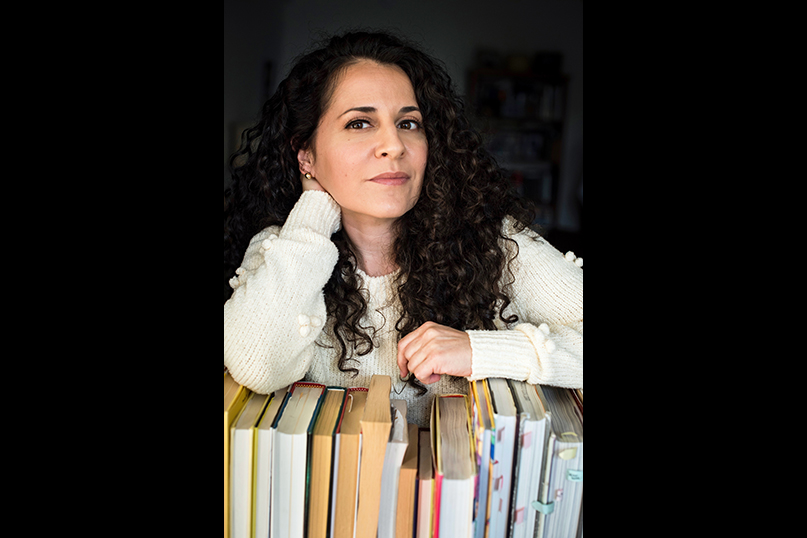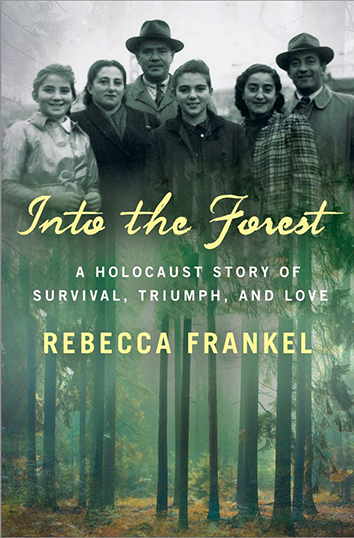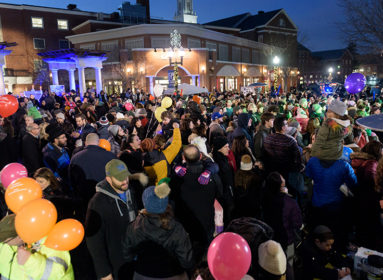
By Stacey Dresner
Rebecca Frankel has close personal ties with the subjects of her new book, Into the Forest, A Holocaust Story of Survival, Trimph and Love.
When she was a child growing up in West Hartford, Frankel’s family belonged to Beth Hillel Synagogue, which was led by Rabbi Philip Lazowski. Into the Forest is the story of the rabbi’s wife, Ruth, who as a child, hid from the Nazis with her family in the Bialowieza Forest near the Polish town of Zhetel.

“I remember how warm and loving the Lazowskis were,” Frankel remembers. Thought she calls both Lazowskis [they] “very special,” she also notes that “Their personalities are very different. He has a little bit of mischief in his eye and could always be counted on for a hard candy. She is very warm.”
Frankel became aware of the Lazowskis’ wartime experiences early on.
In the fourth grade, she recalls, the Lazowskis visiting her Hebrew school classroom to talk to students about the Holocaust. Rabbi Lazowski’s experiences during the Holocaust are well known in the Greater Hartford area – he has not only spoken about his life many times in public forums, but also wrote a memoir, Faith and Destiny.
However, in Into the Forest, published Sept. 7, Frankel shines a spotlight on Ruth’s family – her parents Morris and Miriam Rabinowitz, their extended family and their lives in the Polish towns where they grew up, and their flight from the Zhetel ghetto during its liquidation to the Bialowieza Forest. With other fragmented families and partisan fighters – both Polish and Jewish — the Rabinowitz family hid in the forest from the summer of 1942 until the Soviets arrived in 1944.
Frankel will discuss her new book at a free Sunday morning Brotherhood breakfast at The Emanuel Synagogue on Oct. 3 as part of a weekend-long L’chayim Tribute Shabbaton honoring the Lazowskis and Rabbi David Small ands wife Debbie Chameides. The celebration also includes a Friday night oneg, a Shabbat morning kiddush, and a Saturday night tribute program. Frankel’s Sunday talk, in conversation with Andy Fleischmann and Ruth Lazowski, is sponsored by The Emanuel Synagogue and Voices of Hope.
Frankel got the idea to write the book while working as an editor at Moment magazine several years ago.
“We did a feature called ‘Love Stories from the Holocaust.’ When the editorial team was talking about how to find these stories, I said, ‘I know one actually,’” she recalls.
That love story belonged to the Lazowskis. The Moment story told of how Ruth’s mother Miriam came to the aid of young Philip in the ghetto and how many years later they were all reunited – with Philip marrying Miriam’s daughter Ruth.
For several years after that article was published, Frankel thought about writing a book about the Lazowskis.
In 2015, she reached out to Ruth. She began interviewing her in February 2016. “I was in Connecticut and I spent two weeks doing hours-long interviews with her,” says Frankel, who later also interviewed Ruth’s younger sister, Toby Langerman.
In her book, Frankel introduces the readers to the Rabinowitz family, weaving in family history along with the political and Jewish history of Zhetel, the small town where both of Ruths parents — Miriam Dworetsky and Morris Rabinowitz — were born and raised.
Over the years, Zhetel had belonged to Russia, Lithuania, Sweden, and Germany, but by 1921 it was a part of Poland.
“I had to sharpen my education about the politics of pre-, during- and post-war Poland. I had to educate myself about the town of Zhetel, which I learned mostly through testimony that’s the preservation of this town’s history,” she explains.
Miriam and Morris are the heart and soul of the book. Miriam, a tiny, independent spitfire who owned her own small patent medicine shop in Zhetel, was 24 years old before she married Morris Rabinowitz, a tall lumber mill worker. The couple settled in Zhetel, had their two daughters – then known as Rochel and Tania – and spent a few idyllic years, relatively untouched by antisemitism.
Frankel weaves the Rabinowitz’s story through the lens of World War II – Germany’s invasion of Poland; Russia’s occupation of Zhetel; the young family’s flight from Zhetel to Novogrudek and back to Zhetel; and their confinement in a Jewish ghetto in Zhetel in the winter of 1942.
It was in the ghetto that Miriam first came in contact with a young Philip Lazowski. During a ghetto selection, where a child alone – like Philip – would be sent with the group to be killed, Miriam, who had working papers told the German guards that the young boy was her son.
“I think, for both sides of the family, that intervention is really [the Lazowskis’] origin point,” Frankel says.
Morris, Miriam, seven-year-old Rochel and five-year-old Tania, eventually made it into the 580-acre Bialowieza forest, filled with ancient oaks and swampland, after a harrowing escape from the ghetto.
In a series of conversation with Ruth and Toby, Frankel culled the memories of very, very young children,” which she says recalled living in bunkers dug out from the earth; hunger and illness. Both girls suffered from body lice and rashes and Miriam nearly died from Typhus. Morris nursed his wife back to health. Given his skill as a former lumber worker, he had a keen knowledge of the woods and became a “reluctant leader” for the families gathered in the forest.
“There was something truly remarkable about Morris and Miriam’s love for each other that endured everything and made them stronger,” Frankel says.
The book follows the Rabinowitz family from their liberation from the woods by the Red Army in 1944, to the family’s difficult journey to Italy where they lived as refugees before coming to the United States, and settling in Hartford.
And of course, it tells the story of a chance encounter at a Brooklyn wedding in 1953 that would end up reuniting Miriam with Philip Lazowski – the youngster she had saved during the Zhetel ghetto selection. Philip wed Ruth in 1955 and have shared their own enduring love story ever since.
Frankel uses the term “karmic righteousness,” that appeared in a review of her book, to describe how the fates brought Lazowski and the Rabinowitz family together after war.
“It’s such a beautiful description of what happened, given everything this family lived through,” she says. “The legacy being those moments of intervention, bravery and maternal instinct.”







 Southern New England Jewish Ledger
Southern New England Jewish Ledger














